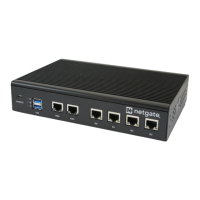Product Manual, TNSR 19.02
Add TNSR LAN Interface to the Instance
The Management and WAN Interfaces were created while launching the instance. Now create the LAN interface. If
this instance requires additional interfaces, either public or private, create those now.
To allocate a new TNSR LAN Network Interface, create a new Elastic Network Interface on the LAN subnet follow-
ing the instructions here https://docs.aws.amazon.com/AWSEC2/latest/UserGuide/using-eni.html#create_eni
The subnet connected to the TNSR LAN interface is a private network which is using the TNSR instance as its
Internet gateway. It can have a much less restrictive Security Group set so that traffic from the LAN can reach the
TNSR instance. Select the default Security Group for the VPC, which should allow all inbound traffic.
Note: The Description field is optional when creating a Network Interface but the best practice is to enter Descrip-
tion text that identifies the interface so it can be easily identified when it is attached to an instance.
To attach the LAN Network Interface to the instance, follow the instructions at https://docs.aws.amazon.com/
AWSEC2/latest/UserGuide/using-eni.html#attach_eni_running_stopped
Prepare TNSR Network Interfaces
The TNSR WAN and LAN interfaces should have Source/Destination Check disabled in order to allow the TNSR
instance to route packets. If these settings are not disabled, packets from the LAN subnet to the Internet will be
dropped before reaching the TNSR LAN interface.
To disable Source/Destination Check for a Network Interface, follow the instructions at https://docs.aws.amazon.
com/AWSEC2/latest/UserGuide/using-eni.html#change_source_dest_check
Connect Management and WAN Interfaces to the Internet
The Management Interface and the TNSR WAN interface must be assigned public Elastic IP Addresses by AWS.
For each interface that needs a public Elastic IP Address, allocate one by following the instructions at https://docs.aws.
amazon.com/AWSEC2/latest/UserGuide/elastic-ip-addresses-eip.html#using-instance-addressing-eips-allocating
Make a note of the allocated Elastic IP Address.
Before associating an Elastic IP Address to a Network Interface, make a note of the ID of the Network Interface to
use. To find the Network Interface ID:
1. Navigate to https://console.aws.amazon.com/ec2/
2. Click Instances
3. Click the button next to the TNSR interface to select it
4. Look at the bottom of the page, under the Description tab to see Network Interfaces
5. Click on the interface names to display information about the Network Interface:
• eth0 for management interface
• eth1 for WAN interface
6. Write down the Interface ID for each interface
After allocating the Elastic IP Addresses and finding the Network Interface IDs for eth0 and eth1, associate the Elastic
IP Addresses to the Network Interfaces by following the instructions at https://docs.aws.amazon.com/AWSEC2/latest/
UserGuide/using-eni.html#associate_eip
1.2. Cloud Platforms 42

